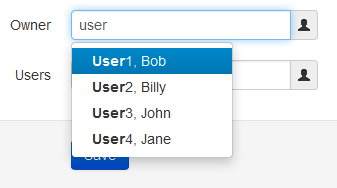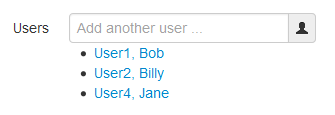lifo / typeahead-bundle
A Symfony bundle that provides an autocomplete Typeahead form type compatible with Bootstrap v2|v3
Installs: 117 475
Dependents: 0
Suggesters: 0
Security: 0
Stars: 22
Watchers: 3
Forks: 12
Open Issues: 5
Type:symfony-bundle
pkg:composer/lifo/typeahead-bundle
Suggests
- mopa/bootstrap-bundle: Bundle to automatically enable Bootstrap styles for Symfony
- twbs/bootstrap: Bootstrap framework
README
This is a Symfony v2.2+ Bundle that provides a Bootstrap (v2.x or v3.x) Typeahead widget for use in forms. The Typeahead component used in this bundle is the original Bootstrap v2.3 Typeahead library with a few enhancements.
Update: If you were pointing to dev-master in your composer.json and this bundle stopped working change your version to
"^1.*" and run composer update lifo/typeahead to update your project.
- If you are using Bootstrap v2.x then you must use version 1.* of this bundle.
- If you are using Bootstrap v3.x then you must use version 2.* of this bundle.
Note: This bundle does not use the newer Twitter/Typeahead.js javascript library.
Enhanced Typeahead Features
This bundle adds a few enhancements to the original bootstrap typeahead javascript library:
- Supports JSON objects
- Caches results
- Delays AJAX request to reduce server requests
- Properly handles pasting via mouse
- Includes an
AJAX Loadericon - Supports Non-Entity lookup
- Supports non AJAX loading via a custom callback function
Screenshots
This example shows a form field that allows a single name to be entered.
This example shows a form field that allows multiple names to be entered. Clicking on a name link removes the entity. The entity in the backend is actually an ArrayCollection and automatically allows adding/removing entities from the list.
How to install
Note: This bundle requires jQuery and Bootstrap to be installed in your environment but does not include them directly. I suggest using the mopa/bootstrap-bundle which can help with this for you.
-
Add
lifo/typeahead-bundleto the "requires" section of your project'scomposer.jsonfile, which can be done automatically by running the composer command from within your project directory:composer require lifo/typeahead-bundleor manually by editing the composer.json file:
{ // ... "require": { // ... "lifo/typeahead-bundle": "^2.0" } }
-
Run
composer updatein your project root. -
Update your project
app/AppKernel.phpfile and add this bundle to the $bundles array:$bundles = array( // ... new Lifo\TypeaheadBundle\LifoTypeaheadBundle(), );
-
Add
@lifo_typeahead_jsto your Asseticjavascriptsblock. Similar to the block below. Your actual setup may differ. Be sure to include it AFTER your jquery and bootstrap libraries.{% javascripts filter='?yui_js' output='js/site.js' '@lifo_typeahead_js' %} <script src="{{ asset_url }}"></script> {% endjavascripts %} -
Add
@lifo_typeahead_cssto your Asseticstylesheetsblock. Similar to the block below. Your actual setup may differ.{% stylesheets filter='cssrewrite,?yui_css' output='css/site.css' '@lifo_typeahead_css' -%} <link href="{{ asset_url }}" type="text/css" rel="stylesheet" /> {% endstylesheets %} -
If you're not using
Asseticthen you will have to manually include the javascript and css files into your project.<link href="{{ asset('bundles/lifotypeahead/css/typeaheadbundle.css') }}" type="text/css" rel="stylesheet" /> <script src="{{ asset('bundles/lifotypeahead/js/bootstrap-typeahead.js') }}"></script> <script src="{{ asset('bundles/lifotypeahead/js/typeaheadbundle.js') }}"></script>
How to use
Using the typeahead control is extremely simple. The available options are outlined below:
$builder->add('user', 'entity_typeahead', array( 'class' => 'MyBundle:User', 'render' => 'fullname', 'route' => 'user_list', ));
Options
classis your entity class. Ifnull(or not specified), the items returned from your controller AJAX response do not have to be Entities. If not blank, the class is used to map the items to your DB Entities.sourceis the name of a function to call that will collect items to display. This orroutemust be specified. The prototype is:function(query, process)whereprocessis the callback your function should call after you've fetched your list of matching items. It expects a FLAT array of strings to render into the pull down menu (Not {id:'...', value:'...'} objects!). See the example below for more information.routeis the name of the route to fetch entities from. The controller matching the route will receive the following parameters viaPOST:queryThe query string to filter results by.limitThe maximum number of results to return.renderThe configuredrendername. This is what you should use to set thevalueattribute in the AJAX response.propertyThe configuredpropertyname. Normally this isid. This is what you should use to set theidattribute in the AJAX response.
route_paramsExtra parameters to pass to theroute.minLengthMinimum characters needed before firing AJAX request.itemsMaximum items to display at once (default: 8)delayDelay in milliseconds before firing AJAX (default: 250)spinnerClass string to use for loading spinner (default: "glyphicon glyphicon-refresh spin") Font-Awesome example: "fa fa-refresh fa-spin fa-fw"multipleIf true the widget will allow multiple entities to be selected. One at a time. This special mode creates an unordered list below the typeahead widget to display the selected entities.callbackCallback function (or string) that is called when an item is selected. Prototype:function(text, data)wheretextis the label of the selected item anddatais the JSON object returned by the server.renderis the property of your entity to display in the typeahead input. This is used to render the initial value(s) into the widget. Once a user starts typing, the rendered responses are dependent on therouteorsourceused.
AJAX Response
The controller should return a JSON array in the following format. Note: id and value properties are required but
you may include other properties as well.
[ { id: 1, value: 'Displayed Text 1' }, { id: 2, value: 'Displayed Text 2' } ]
Note: If you are using a null class option then your JavaScript array should return an id and value that are
the same thing. e.g:
[ { id: 'Result 1', value: 'Result 1' }, { id: 'Result 2', value: 'Result 2' } ]
If you do not return the same string for the id and value you will get confusing results in your UI.
Custom Source Callback
Here is an example of a custom source callback. This example mimics the same result if you had used the route option.
function get_users(query, process) { $.post('/mysite/lookup/users', {query: query}, 'json') .success(function (data) { // must convert the data array into a flat list of strings. // If your lookup function already returns a flat list, then $.map() is not needed. process($.map(data, function(a){ return a.value; })); }); }
$builder->add('user', 'entity_typeahead', array( 'class' => 'MyBundle:User', 'render' => 'fullname', 'source' => 'get_users', // a function name in the global javascript "window" object ));
Template
Your form template might look something like this (The screenshots above used this template bit).
Note: The widget_addon attribute is a mopa/bootstrap-bundle attribute.
{{ form_row(form.name) }}
{{ form_row(form.owner, { attr: { placeholder: 'Search for user ...'}, widget_addon: {type: 'append', 'icon': 'user'}}) }}
{{ form_row(form.users, { attr: { placeholder: 'Add another user ...'}, widget_addon: {type: 'append', 'icon': 'user'}}) }}
Notes
This bundle renders its form elements in standard Symfony style. You will have to override the form blocks to get the proper Bootstrap styles applied. I strongly suggest something like mopa/bootstrap-bundle that will override the Symfony form templates with proper Bootstrap versions automatically for you.


